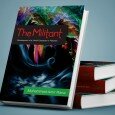By Aasim Akhtar –
We think of twilight as the mingling of the day and the night: a breathing space, sometimes calm, sometimes menacing, in which neither light nor dark prevails. But the name suggests something odder and more specific than this: not the meeting of light and dark, but rather the co-presence of two different lights. As the sun sinks, its light is not steadily withdrawn but subject to a scattering by the air and dust of the atmosphere. For a short period this creates a strange, faint flaring of the air, an oblique blaze in things. Evocations of twilight often reach for the ambivalent colours of precious stones – pearl, opal, sapphire, amethyst – which suggest an eerie kind of earthlight, as though objects themselves were giving out their own illumination, stored during the day and given off as day retreats.
Thomas Hardy’s ‘The Return of the Native’ begins with a literary evocation of twilight as something emblematic of the mental and emotional states of the characters in his novel. Hardy describes the contrast between the “pallid” sky and “embrowned” heath. His opening chapter is unusual for a Victorian novel: an empty stage with no characters described, yet instead a potent landscape, a terrain as much psychological as physical. This scene perhaps presages, or reflects, a growing popular sentiment in Mughees Riaz’s suite of paintings, ‘The River Sutra’ shown at Ejaz Galleries, Lahore, recently.
Mughees Riaz’s paintings are of a strangely lucid atmosphere. Strange, because his pictures, on canvas, do not match our idea of contemporary images – far too common seems a surreal world painted in dark colours. Light itself can rather be found there, where the subject is not related to reality. Considering the current state of the world, one thinks the artistic view into this world should not allow any sun. What might have induced the artist to make lightness itself his main subject? Does he follow an inner mood, a gaiety gained under the sun? Sure enough, Riaz’s personality evokes such an impression in the first place. He is no melancholic in the simple or dim sense of banal imagination, but neither is he a restlessly cheerful optimist.
These paintings do not intend any political aims, social critique or narrative structures. They are painted plainly and herein Riaz takes up painting as a perceived reality, not as abstract relations of colour. Their subjects, horizontal strand panoramas, the view over the waterfront onto the river’s sun-shimmering, which resolves figures and water into each other or a view looming low above the edge, let any narration step back. This reduced variety of themes emphasizes painting even more richly. Instead of all brooding, the problem however is to create a deeper expression of colour with both these dark planes and a condensed palette. Apart from the literal sense of the phrase, until today stepping into nature has seemed to be no issue of painting any longer, but without turning into a neo-Impressionist, Riaz has made the subject of nature credible again as a topic of painting.
Along the banks of river Ravi, vast tracts of the water ridge remain wild and undeveloped, while the lowland reaches are still eerily uninhabited. Headlands have been battered into shape by ferocious westerlies whose sheer relentlessness has stunted trees, suppressed grasses, and wrecked boats in terrifying numbers. There is a sense of escape, exploration and solitariness. Winter fog softens the atmosphere while low lying light casts long shadows from ancient trees. There’s no doubt that this raw beauty has lured, inspired, enrapt, and obsessed artists since European occupation. However, Mughees Riaz’s contemporary landscape does not represent the sublime alone. Riaz’s relationship with the Ravi is grounded in his family’s long-standing connection with the farming land of the city’s midlands where he has lived most of his life. His paintings of the grazed plains and windswept central plateau are fuelled by an intuitive knowledge of the area that comes only to one who has spent years in a particular place. For each solo exhibition he undertakes, Riaz completes numerous paintings of one specific aspect of the region in order to capture its essential qualities. In these paintings the artist combines his innate understanding of the area with acute observational skill to develop works of extreme physicality.
Although usually grand in execution, the paintings also exist as an intimate document between artist and land. Their textural surfaces are constructed as if Riaz has tenderly remodelled the landscape, adjusting vital elements ever so slightly to create a world that is a small step from reality. The world he depicts is not bucolic, but neither is it quite as harsh as the actual trampled embankment. Instead, Riaz’s landscapes are gentle and a fraction hazy, as if it’s a faithful but subtly altered memory of a unique place.
Interestingly for paintings of this scale, there is an absence of a significant or overpowering landform. Instead, Riaz has invested a quietly beautiful but relatively inconsequential aspect of the environment with the same attention Romantic painters might have attributed a mountain range. The artist’s closeness to the landscape is evidenced by his choice of modest subject, which he has discovered by traversing the Ravi on foot. But it is also his uncanny ability to mimic the earthly colours and southern light unique to Lahore, which underlies the artist’s understanding of the nature of this place. When united with the low perspective and large scale of each painting, Riaz’s precise distillation of colour imbues his work with particular intensity, creating within the viewer a sense that they are actually in the landscape experiencing the shifting weather and light patterns.
Mughees Riaz’s imagery is sophisticated in its ability to polarise the viewer’s emotional response to the river and its surrounds. At a fundamental level, the images depict the river in its naked reality – as irreparably altered expanse of water. The skeletons of trees rise from the water’s still surface, islands float where water once stood, and there is no naturally formed gradient, sand or scrub to separate the water’s edge from the shore. However, Riaz brings a complex and paradoxical reading to this imagery. Although he does not deny the lifeless atmosphere of these environments, his treatment of each image stirs a sense of wonder in such unearthly places. The silvery surface of each riverscape is enchanting, mist shrouds the horizon, and clouds hover dramatically above each lagoon. These are supremely sublime elements that cast a breathtaking atmosphere over the artificial environments. It is as if the viewer has stumbled across a new ‘wilderness’, which is fearful, awesome and sublime.
Riaz rarely paints the natural environment without referring to human presence. This presence might be represented quite literally by images of people in the landscape (the solitary figure in ‘The Flow’ or the sleeping (read dead) figure in a stranded boat after ‘Inspired by Jacques Louis David’s Death of Marat’), but it is also alluded to in unpeopled landscapes by a gypsy tent or a chair. The riverscape often appears as a backdrop or a stage while the characters (the camel, the horse, the buffaloes, the crows) move in and out of the frame. These paintings create the impression of a suspension in time and space and encourage our peripheral awareness. We sense the significance of these images but cannot entirely pin them down, and we are left with a feeling of premonition. With each sinking of the sun, and the melting of form and colour into the sky, we might draw a parallel with the slow fade of our own lives. Immersed in the gloaming, it is here that we are brought potentially into the contemplation of our own existence. Obscurity lies at the heart of Riaz’s threat and its appeal – but what is clear is that the magic hour chimes once again with the mood of our times and continues to cast its spell.
The writer is a curator and an art critic


































































































